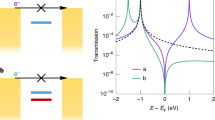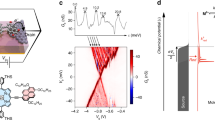Abstract
As the dimensions of a conductor approach the nanoscale, quantum effects begin to dominate, and it becomes possible to control the conductance through direct manipulation of the electron wavefunction. Such control has been demonstrated in various mesoscopic devices at cryogenic temperatures1,2,3,4, but it has proved to be difficult to exert control over the wavefunction at higher temperatures. Molecules have typical energy level spacings (∼eV) that are much larger than the thermal energy at 300 K (∼25 meV), and are therefore natural candidates for such experiments. Previously, phenomena such as giant magnetoresistance5, Kondo effects6 and conductance switching7,8,9,10,11 have been observed in single molecules, and theorists have predicted that it should also be possible to observe quantum interference in molecular conductors12,13,14,15,16,17,18, but until now all the evidence for such behaviour has been indirect. Here, we report the observation of destructive quantum interference in charge transport through two-terminal molecular junctions at room temperature. We studied five different rigid π-conjugated molecular wires, all of which form self-assembled monolayers on a gold surface, and find that the degree of interference can be controlled by simple chemical modifications of the molecular wire.
This is a preview of subscription content, access via your institution
Access options
Subscribe to this journal
Receive 12 print issues and online access
$259.00 per year
only $21.58 per issue
Buy this article
- Purchase on Springer Link
- Instant access to full article PDF
Prices may be subject to local taxes which are calculated during checkout




Similar content being viewed by others
References
Webb, R. A., Washburn, S., Umbach, C. P. & Laibowitz, R. B. Observation of h/e Aharonov–Bohm oscillations in normal-metal rings. Phys. Rev. Lett. 54, 2696–2699 (1985).
van Wees, B. J. et al. Quantized conductance of point contacts in a two-dimensional electron gas. Phys. Rev. Lett. 60, 848–850 (1988).
Wharam, D. A. et al. One-dimensional transport and the quantisation of the ballistic resistance. J. Phys. C 21, L209–L214 (1988).
Beenakker, C. W. J. & van Houten, H. Quantum transport in semiconductor nanostructures. Solid State Phys. 44, 1–228 (1991).
Schmaus, S. et al. Giant magnetoresistance through a single molecule. Nature Nanotech. 6, 185–189 (2011).
Park, J. et al. Coulomb blockade and the Kondo effect in single-atom transistors. Nature 417, 722–725 (2002).
Smit, R. H. M. et al. Measurement of the conductance of a hydrogen molecule. Nature 419, 906–909 (2002).
Kubatkin, S. et al. Single-electron transistor of a single organic molecule with access to several redox states. Nature 425, 698–701 (2003).
Venkataraman, L. et al. Single-molecule circuits with well-defined molecular conductance. Nano Lett. 6, 458–462 (2006).
Mishchenko, A. et al. Influence of conformation on conductance of biphenyl-dithiol single-molecule contacts. Nano Lett. 10, 156–163 (2010).
Van der Molen, S. J. & Liljeroth, P. Charge transport through molecular switches. J. Phys. Condens. Matter 22, 133001 (2010).
Sautet, P. & Joachim, C. Electronic interference produced by a benzene embedded in a polyacetylene chain. Chem. Phys. Lett. 153, 511–516 (1988).
Andrews, D. Q., Solomon, G. C., Van Duyne, R. P. & Ratner, M. A. Single molecule electronics: increasing dynamic range and switching speed using cross-conjugated species. J. Am. Chem. Soc. 130, 17309–17319 (2008).
Stafford, C. A., Cardamone, D. M. & Mazumdar, S. The quantum interference effect transistor. Nanotechnology 18, 424014 (2007).
Ernzerhof, M., Zhuang, M. & Rocheleau, P. Side-chain effects in molecular electronic devices. J. Chem. Phys. 123, 134704 (2005).
Markussen, T., Stadler, R. & Thygesen, K. S. The relation between structure and quantum interference in single molecule junctions. Nano Lett. 10, 4260–4265 (2010).
Markussen, T., Schiotz, J. & Thygesen, K. S. Electrochemical control of quantum interference in anthraquinone-based molecular switches. J. Chem. Phys. 132, 224104 (2010).
Solomon, G. C., Herrmann, C., Hansen, T., Mujica, V. & Ratner, M. A. Exploring local currents in molecular junctions. Nature Chem. 2, 223–228 (2010).
Yaliraki, S. & Ratner, M. Interplay of topology and chemical stability on the electronic transport of molecular junctions. Ann. NY Acad. Sci. 960, 153–162 (2002).
Patoux, C., Coudret, C., Launay, J. P., Joachim, C. & Gourdon, A. Topological effects on intramolecular electron transfer via quantum interference. Inorg. Chem. 36, 5037–5049 (1997).
Ricks, A. B. et al. Controlling electron transfer in donor-bridge-acceptor molecules using cross-conjugated bridges. J. Am. Chem. Soc. 132, 15427–15434 (2010).
Mayor, M. et al. Electric current through a molecular rod—relevance of the position of the anchor groups. Angew. Chem. Int. Ed. 42, 5834–5838 (2003).
Fracasso, D., Valkenier, H., Hummelen, J. C., Solomon, G. C. & Chiechi, R. C. Evidence for quantum interference in SAMs of arylethynylene thiolates in tunneling junctions with eutectic GaIn (EGaIn) top-contacts. J. Am. Chem. Soc. 133, 9556–9563 (2011).
Hong, W. et al. An MCBJ case study: the influence of π-conjugation on the single-molecule conductance at a solid/liquid interface. Beilstein J. Nanotechnol. 2, 699–713 (2011).
Van Dijk, E. H., Myles, D. J. T., van der Veen, M. H. & Hummelen, J. C. Synthesis and properties of an anthraquinone-based redox switch for molecular electronics. Org. Lett. 8, 2333–2336 (2006).
Valkenier, H. et al. Formation of high-quality self-assembled monolayers of conjugated dithiols on gold: base matters. J. Am. Chem. Soc. 133, 4930–4939 (2011).
Wold, D. J. & Frisbie, C. D. Fabrication and characterization of metal–molecule–metal junctions by conducting probe atomic force microscopy. J. Am. Chem. Soc. 123, 5549–5556 (2001).
Gonzalez, M. T. et al. Electrical conductance of molecular junctions by a robust statistical analysis. Nano Lett. 6, 2238–2242 (2006).
Bergfield, J. P. & Stafford, C. A. Thermoelectric signatures of coherent transport in single-molecule heterojunctions. Nano Lett. 9, 3072–3076 (2009).
Quek, S. Y., Choi, H. J., Louie, S. G. & Neaton, J. B. Length dependence of conductance in aromatic single-molecule junctions. Nano Lett. 9, 3949–3953 (2009).
Acknowledgements
The authors thank T. Oosterkamp and F. Galli for making their equipment and expertise available, J. van Ruitenbeek and M. Trouwborst for discussions and D. Myles for his initial synthetic efforts. This study was financed by a VIDI grant (to S.J.vdM.) from the Netherlands Organization for Scientific Research (NWO), by the Dutch Ministry of Economic Affairs via NanoNed (to H.V., project GMM.6973), by the FTP (grant no. 11-104592 to T.M.) and The Sapere Aude program under the Danish Council for Independent Research (grant no. 11-105139 to K.S.T.).
Author information
Authors and Affiliations
Contributions
C.M.G., H.V. and S.J.vdM. performed AFM measurements and carried out data analysis. H.V. and J.C.H. designed and synthesized the molecules, and made and characterized the SAMs. T.M. and K.S.T. performed the calculations. C.M.G., H.V., J.C.H. and S.J.vdM. designed the experiment. All authors discussed the results and commented on the manuscript.
Corresponding author
Ethics declarations
Competing interests
The authors declare no competing financial interests.
Supplementary information
Supplementary information
Supplementary information (PDF 35457 kb)
Rights and permissions
About this article
Cite this article
Guédon, C., Valkenier, H., Markussen, T. et al. Observation of quantum interference in molecular charge transport. Nature Nanotech 7, 305–309 (2012). https://doi.org/10.1038/nnano.2012.37
Received:
Accepted:
Published:
Issue Date:
DOI: https://doi.org/10.1038/nnano.2012.37
This article is cited by
-
Quantum interference enhances the performance of single-molecule transistors
Nature Nanotechnology (2024)
-
Microscopic theory, analysis, and interpretation of conductance histograms in molecular junctions
Nature Communications (2023)
-
Quantum interference effects elucidate triplet-pair formation dynamics in intramolecular singlet-fission molecules
Nature Chemistry (2023)
-
Future Potential of Quantum Computing and Simulations in Biological Science
Molecular Biotechnology (2023)
-
Removing the Destructive Quantum Interference in Cross Conjugation System by Structural Restraint
Chemical Research in Chinese Universities (2023)



